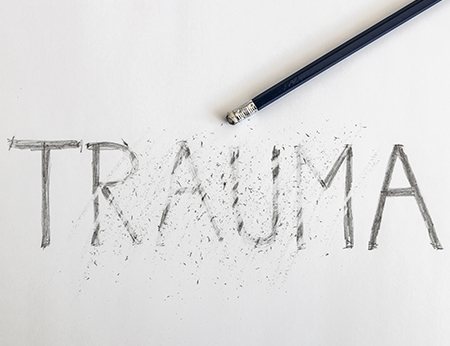If you have gone through trauma, big or small, and you’re looking for lasting healing, you are in the right place.
 Let’s start with what trauma IS…
Let’s start with what trauma IS…
Trauma can result from a large-scale horrifying event like war or childhood abuse. Or it can result from multiple smaller events over time like medical procedures, car accidents, or repeatedly being neglected, bullied, or ignored as a child.
Dr. Peter Levine, author of Waking the Tiger and creator of Somatic Experiencing (SE) trauma therapy, describes trauma as “the often debilitating symptoms that people suffer in the aftermath of perceived life-threatening or overwhelming experiences.”
This definition notes two important things about trauma. First, it doesn’t matter if what you went through was actually life-threatening or overwhelming. If you perceived it that way, your body responded as if it were. Second, trauma invokes a physiological response, not a mental one. So, it’s not “all in your head.” It is literally all in your body.
 Trauma doesn’t look the same for everyone.
Trauma doesn’t look the same for everyone.
Trauma separates us from ourselves, our bodies, and the world around us.
It narrows our vision. It limits our lives.
It keeps us constantly reacting in the present in a way that keeps us guarded against the trauma of the past.
It can look a little different for everyone, but what trauma has in common is that it keeps you stuck, guarded, or fearful in some (or many) aspects of your life.
One of my clients had anxiety as a car passenger, which affected her mental health and relationship. She and her husband liked to drive out to their property on the weekends; anytime she got in the car as the passenger, she could not relax. She would spend the drive anxious, on edge, looking for danger everywhere, and nit-picking his driving to the point it caused many arguments.
I’ve worked with clients who can’t find stability in their work, relationships, or even living situations due to unresolved trauma.
One of my clients had ongoing jaw pain that affected her ability to sleep properly, enjoy food, and even perform her job duties as a teacher. She had spent a lot of time and money working on her jaw with other healthcare professionals, but until we addressed the trauma imprint behind it, the pain wouldn’t relent.
 Healing trauma takes time, energy, commitment, and patience.
Healing trauma takes time, energy, commitment, and patience.
Trauma healing isn’t just about moving through the dark terrain and hard things. It is also about uncovering your most essential and embodied self.
It takes time to unlearn if you have lived in a trauma response pattern for many years. You can think about it like a well-established path in your brain, a path you’ve been taking daily, wearing down the tall grass in the field of your mind.
Through this work, you will start developing new pathways in your brain, which takes time to develop. You will learn ways to recognize when the old pattern/trauma response is first activated and how to start changing the automatic response, so you don’t trudge down that same old pathway right away. This simply takes time, commitment, energy, and patience.
You will probably get frustrated at some point with thinking it isn’t working fast enough. We live in a culture that validates instant gratification, but we can’t flip a switch and instantly change decades-old responses.
But we can change them! And the good news is, even while you are patiently creating new pathways and building more resiliency and regulation into your nervous system, you begin to notice small changes and feel better.
Patience comes from noticing and feeling small changes, new pathways being formed and walked a few days, then weeks, in a row. I will point out your progress, even if it is hard for you to see it in the moment. In working with your nervous system, we have to honor the pace of your nervous system. And this is generally a slower pace than we are used to. The good news is that as you learn to live in rhythm with your system’s natural pacing, life becomes easier and more fluid.
It’s hard work, but it’s worth doing so that you can heal and return to your true self!
Let’s rediscover who you are…
Because your authentic self is separate from what happened to you, your social conditioning, and the patterns you’ve developed.
I’m not saying all of your past experiences and patterns will completely disappear, but there will be more of YOU and less of them.
Imagine your body as a container filled half with your essential self and half with everything you’ve accumulated on your journey. That means that your life choices are split between these two forces.
In our work together, you will access more of your essential self, and the ratio will slowly shift so that you are the driving force behind your choices – not your trauma.
 When you experience a traumatic event…
When you experience a traumatic event…
Large amounts of energy (activation energy) get stirred up in the body to help you survive.
Remembering that trauma is anything we perceive as life-threatening, it makes sense that our bodies undergo a survival response to keep us alive.
This survival response can take different forms, but all require a lot of energy to mobilize in your body. Common survival responses are fight, flight, freeze, and appease. Even though the freeze and appease responses might seem passive, a lot of energy still goes into them. Underneath a freeze response is a LOT of energy. You may find this in your own experience of working with trauma.
In traumatic situations, the surge of energy cannot naturally move through the body. With animals in the wild, for example, an antelope chased by a lion will run swiftly, flight response fully engaged, heart and legs pumping. After the antelope evades the lion and can stop running, his body naturally wants to shut off the flight response and return to homeostasis. The large amount of activation energy required to get him moving is still active and needs to be completed so he can return to a baseline state. The animal’s body knows exactly what to do, and it will twitch and shake to deactivate the survival energy. This happens naturally, with no thought from the antelope. Eventually, he will stop twitching, and his body will reenter a normalized state. He will resume his day-to-day antelope activities and go about his business.
In humans, that response can become thwarted. Perhaps trying to run or fight wasn’t safe, so all of that activation energy stirred up in your body without a chance to dissipate. Maybe the response was unsuccessful, and you learned to override it or shut it down. Our bodies repeatedly look for ways to process this event so that the energy can complete what it didn’t get the chance to do at the time.
This can show irritation; difficulty communicating; fear of new situations, places, or people; a tendency to shut down or disassociate when difficult things arise; chronic pain; headaches; fatigue; depression; or anxiety.
 We’re going to take a body-based approach.
We’re going to take a body-based approach.
As the result of trauma, one or more of these experiences may have brought you here today.
Since trauma is a physiological (body-based) phenomenon giving rise to problematic emotional and mental responses, it makes sense to begin working with your physiology to heal trauma (rather than the other way around!).
Somatic Experiencing is what’s known as a “bottom-up” approach (working from the body first) rather than a “top-down” approach (working first with the mind) like Cognitive-Behavioral Therapy (CBT).
This means you don’t have to relive traumatic events. It doesn’t even matter if you don’t have a clear or conscious memory of what happened. We will work with your body’s responses more than the story behind them.
Trust the part of you that says YES!
If you are ready to make lasting, profound changes and heal those barriers, old wounds, and unhelpful patterns so that you can open more of your heart and soul up to the world, I encourage you to reach out.
It can be scary to dive into the dark corners of ourselves to address shame, fear, anger, or scarcity. I don’t try to pretend otherwise. But in doing this work, we move at a slow pace. We move at the pace your system can acclimate to, so you feel supported and unhurried every step.
Before we dig around dark corners, we ensure you know where all the lights are and how to turn them on. We build resources and resilience into your system. You learn how to develop and grow these things for yourself through our work together so that you are the masterful healer of your internal environment. I am here to light the path and support you.
If you are curious about healing your trauma, reach out and schedule your free 20-minute consultation call to see if we would be a good fit for working together: (619) 432-2991.

